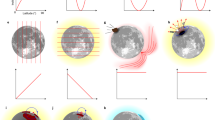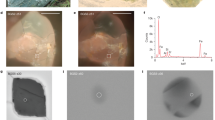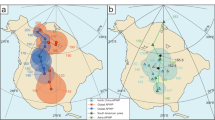Abstract
Palaeomagnetism of climatically sensitive sedimentary rock types, such as glacial deposits and evaporites, can test the uniformitarianism of ancient geomagnetic fields and palaeoclimate zones. Proterozoic glacial deposits laid down in near-equatorial palaeomagnetic latitudes can be explained by ‘snowball Earth’ episodes, high orbital obliquity or markedly non-uniformitarian geomagnetic fields. Here I present a global palaeomagnetic compilation of the Earth’s entire basin-scale evaporite record. Magnetic inclinations are consistent with low orbital obliquity and a geocentric-axial-dipole magnetic field for most of the past two billion years, and the snowball Earth hypothesis accordingly remains the most viable model for low-latitude Proterozoic ice ages. Efforts to reconstruct Proterozoic supercontinents are strengthened by this demonstration of a consistently axial and dipolar geomagnetic reference frame, which itself implies stability of geodynamo processes on billion-year timescales.
This is a preview of subscription content, access via your institution
Access options
Subscribe to this journal
Receive 51 print issues and online access
$199.00 per year
only $3.90 per issue
Buy this article
- Purchase on Springer Link
- Instant access to full article PDF
Prices may be subject to local taxes which are calculated during checkout



Similar content being viewed by others
References
Evans, D. A. D. Stratigraphic, geochronological, and paleomagnetic constraints upon the Neoproterozoic climatic paradox. Am. J. Sci. 300, 347–433 (2000)
Evans, D. A. D. A fundamental Precambrian–Phanerozoic shift in Earth’s glacial style?. Tectonophysics 375, 353–385 (2003)
Hoffman, P. F., Kaufman, A. J., Halverson, G. P. & Schrag, D. P. A Neoproterozoic snowball Earth. Science 281, 1342–1346 (1998)
Hoffman, P. F. & Schrag, D. P. The snowball Earth hypothesis: Testing the limits of global change. Terra Nova 14, 129–155 (2002)
Kirschvink, J. L. in The Proterozoic Biosphere: A Multidisciplinary Study (eds Schopf, J. W. & Klein, C.) 51–52 (Cambridge Univ. Press, Cambridge, 1992)
Hyde, W. T., Crowley, T. J., Baum, S. K. & Peltier, W. R. Neoproterozoic ‘snowball Earth’ simulations with a coupled climate/ice sheet model. Nature 405, 425–429 (2000)
Poulsen, C. J. Absence of a runaway ice-albedo feedback in the Neoproterozoic. Geology 31, 473–476 (2003)
Williams, G. E. Late Precambrian glacial climate and the Earth’s obliquity. Geol. Mag. 112, 441–465 (1975)
Williams, G. E. History of the Earth’s obliquity. Earth Sci. Rev. 34, 1–45 (1993)
Vanyo, J. P. & Awramik, S. M. Stromatolites and Earth–Sun–Moon dynamics. Precambr. Res. 29, 121–142 (1985)
Levrard, B. & Laskar, J. Climate friction and the Earth’s obliquity. Geophys. J. Int. 154, 970–990 (2003)
Pais, M. A., Le Mouel, J. L., Lambeck, K. & Poirer, J. P. Late Precambrian paradoxical glaciation and obliquity of the Earth: A discussion of dynamical constraints. Earth Planet. Sci. Lett. 174, 155–171 (1999)
Williams, D. M., Kasting, J. F. & Frakes, L. A. Low-latitude glaciation and rapid changes in the Earth’s obliquity explained by obliquity-oblateness feedback. Nature 396, 453–455 (1998)
Kent, D. V. & Smethurst, M. A. Shallow bias of paleomagnetic inclinations in the Paleozoic and Precambrian. Earth Planet. Sci. Lett. 160, 391–402 (1998)
Bloxham, J. Sensitivity of the geomagnetic axial dipole to thermal core–mantle interactions. Nature 405, 63–65 (2000)
Olson, P. & Christensen, U. R. The time-averaged magnetic field in numerical dynamos with non-uniform boundary heat flow. Geophys. J. Int. 151, 809–823 (2002)
Irving, E. Palaeomagnetic and paleoclimatological aspects of polar wandering. Geofis. Pura Appl. 33, 23–41 (1956)
Irving, E. & Briden, J. C. Palaeolatitude of evaporite deposits. Nature 196, 425–428 (1962)
Opdyke, N. D. in Continental Drift (ed. Runcorn, S. K.) 41–65 (Academic, New York, 1962)
Borchert, H. & Muir, R. O. Salt Deposits (Van Nostrand, London, 1964)
Drewry, G. E., Ramsay, A. T. S. & Smith, A. G. Climatically controlled sediments, the geomagnetic field, and trade wind belts in Phanerozoic time. J. Geol. 82, 531–553 (1974)
Gordon, W. A. Distribution by latitude of Phanerozoic evaporite deposits. J. Geol. 83, 671–684 (1975)
Parrish, J. T., Ziegler, A. M. & Scotese, C. R. Rainfall patterns and the distribution of coals and evaporites in the Mesozoic and Cenozoic. Palaeogeogr. Palaeoclimatol. Palaeoecol. 40, 67–101 (1982)
Besse, J. & Courtillot, V. Apparent and true polar wander and the geometry of the geomagnetic field over the last 200 Myr. J. Geophys. Res. 107 doi: 10.1029/2000JB000050 (2002)
Torsvik, T. H. & Van der Voo, R. Refining Gondwana and Pangea palaeogeography: estimates of Phanerozoic non-dipole (octupole) fields. Geophys. J. Int. 151, 771–794 (2002)
Kent, D. V. & Tauxe, L. Corrected Late Triassic latitudes for continents adjacent to the North Atlantic. Science 307, 240–244 (2005)
Zharkov, M. A. History of Paleozoic Salt Accumulation (Springer, Berlin, 1981)
Van der Voo, R. Paleomagnetism of the Atlantic, Tethys and Iapetus Oceans (Cambridge Univ. Press, Cambridge, 1993)
McElhinny, M. W., Powell, C. M. & Pisarevsky, S. A. Paleozoic terranes of eastern Australia and the drift history of Gondwana. Tectonophysics 362, 41–65 (2003)
Van der Voo, R. & Torsvik, T. H. Evidence for late Paleozoic and Mesozoic non-dipole fields provides an explanation for the Pangea reconstruction problems. Earth Planet. Sci. Lett. 187, 71–81 (2001)
Pope, M. C. & Grotzinger, J. P. Paleoproterozoic Stark Formation, Athapuscow basin, northwest Canada: Record of cratonic-scale salinity crisis. J. Sedim. Res. 73, 280–295 (2003)
Warren, J. K. Evaporites: Their Evolution and Economics (Blackwell Science, Oxford, 1999)
Hunt, B. G. The impact of large variations of the Earth’s obliquity on the climate. J. Meteorol. Soc. Jpn 60, 309–318 (1982)
Jenkins, G. S. Global climate model high-obliquity solutions to the ancient climate puzzles of the Faint Young Sun Paradox and low-altitude Proterozoic Glaciation. J. Geophys. Res. 105, 7357–7370 (2000)
Jenkins, G. S. High-obliquity simulations for the Archean Earth: Implications for climatic conditions on early Mars. J. Geophys. Res. 106, 32903–32913 (2001)
Livermore, R. A., Vine, F. J. & Smith, A. G. Plate motions and the geomagnetic field. I. Quaternary and late Tertiary. Geophys. J. R. Astron. Soc. 73, 153–171 (1983)
Evans, D. A. D. True polar wander and supercontinents. Tectonophysics 362, 303–320 (2003)
Muttoni, G. et al. Early Permian Pangea ‘B’ to Late Permian Pangea ‘A’. Earth Planet. Sci. Lett. 215, 379–394 (2003)
Torsvik, T. H. & Cocks, L. R. M. Earth geography from 400 to 250 Ma: a palaeomagnetic, faunal and facies review. J. Geol. Soc. Lond. 161, 555–572 (2004)
Hunt, B. G. The effects of past variations of the Earth’s rotation rate on climate. Nature 281, 188–191 (1979)
Tauxe, L. Inclination flattening and the geocentric axial dipole hypothesis. Earth Planet. Sci. Lett. 233, 247–261 (2005)
Hallam, A. Continental humid and arid zones during the Jurassic and Cretaceous. Palaeogeogr. Palaeoclimatol. Palaeoecol. 47, 195–223 (1984)
Raub, T. D. & Evans, D. A. D. Magnetic reversals in basal Ediacaran cap carbonates: A critical review. Eos 87 (36)abstract GP41B–02 (2006)
Smirnov, A. V., Tarduno, J. A. & Pisakin, B. N. Paleointensity of the early geodynamo (2.45 Ga) as recorded in Karelia: A single-crystal approach. Geology 31, 415–418 (2003)
Park, J. K. & Jefferson, C. W. Magnetic and tectonic history of the Late Proterozoic Upper Little Dal and Coates Lake Groups of northwestern Canada. Precambr. Res. 52, 1–35 (1991)
Idnurm, M. Towards a high resolution Late Palaeoproterozoic – earliest Mesoproterozoic apparent polar wander path for northern Australia. Aust. J. Earth Sci. 47, 405–429 (2000)
Cocks, L. R. M. & Torsvik, T. H. Earth geography from 500 to 400 million years ago: a faunal and paleomagnetic review. J. Geol. Soc. Lond. 159, 631–644 (2002)
Torsvik, T. H., Van der Voo, R., Meert, J. G., Mosar, J. & Walderhaug, H. J. Reconstructions of the continents around the North Atlantic at about the 60th parallel. Earth Planet. Sci. Lett. 187, 55–69 (2001)
Yang, Z., Yin, J., Sun, Z., Otofuji, Y. & Sato, K. Discrepant Cretaceous paleomagnetic poles between Eastern China and Indochina: a consequence of the extrusion of Indochina. Tectonophysics 334, 101–113 (2001)
Zhao, X., Coe, R. S., Gilder, S. A. & Frost, G. M. Palaeomagnetic constraints on the palaeogeography of China: implications for Gondwanaland. Aust. J. Earth Sci. 43, 643–672 (1996)
Acknowledgements
I thank J. Emerson, K. Grey, J. Grotzinger, P. Hoffman, D. Kent, R. Rainbird, Tim and Theresa Raub, S. Sherwood and P. Southgate for discussions, and R. Van der Voo for constructive comments on the manuscript. The David and Lucile Packard Foundation provided support.
Author information
Authors and Affiliations
Corresponding author
Ethics declarations
Competing interests
Reprints and permissions information is available at www.nature.com/reprints. The author declares no competing financial interests.
Supplementary information
Supplementary Information
This document contains individual descriptions of evaporite deposits, with references to information on stratigraphy, ages, and palaeomagnetic constraints. (DOC 202 kb)
Rights and permissions
About this article
Cite this article
Evans, D. Proterozoic low orbital obliquity and axial-dipolar geomagnetic field from evaporite palaeolatitudes. Nature 444, 51–55 (2006). https://doi.org/10.1038/nature05203
Received:
Accepted:
Issue Date:
DOI: https://doi.org/10.1038/nature05203
This article is cited by
-
High-latitude platform carbonate deposition constitutes a climate conundrum at the terminal Mesoproterozoic
Nature Communications (2024)
-
Sulfate triple-oxygen-isotope evidence confirming oceanic oxygenation 570 million years ago
Nature Communications (2023)
-
Deconstructing plate tectonic reconstructions
Nature Reviews Earth & Environment (2023)
-
Sustaining Earth’s magnetic dynamo
Nature Reviews Earth & Environment (2022)
-
Ordovician–Silurian true polar wander as a mechanism for severe glaciation and mass extinction
Nature Communications (2022)
Comments
By submitting a comment you agree to abide by our Terms and Community Guidelines. If you find something abusive or that does not comply with our terms or guidelines please flag it as inappropriate.



